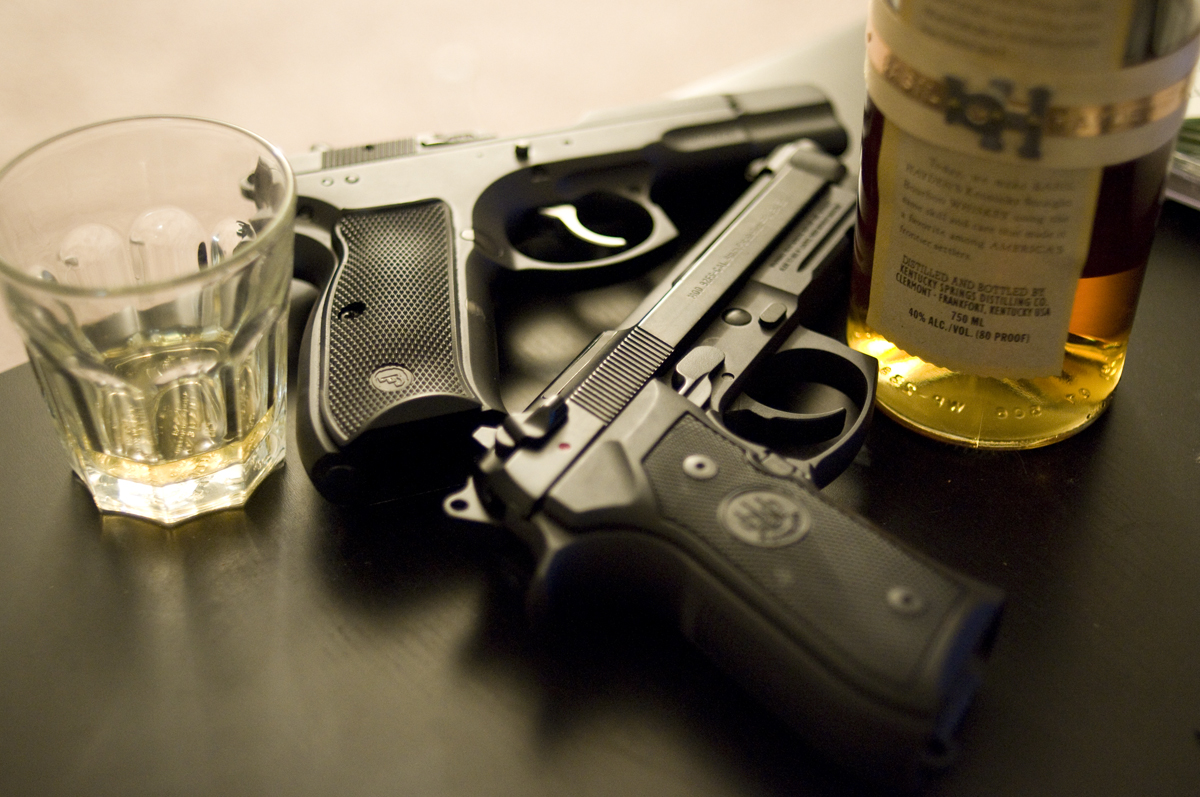Gun owners who have been convicted of an alcohol-related offense, such as driving under the influence or drunk and disorderly conduct, are up to five times as likely to be arrested for a violent or firearm-related crime than those who have not, new research shows.
The study, conducted by researchers from the Violence Prevention Research Program at the University of California, Davis, found that a conviction for a crime involving alcohol is a much greater indication of future violent behavior than a conviction for almost any other offense — including other violent ones.
“One finding that really struck me was that when you threw alcohol and other kinds of criminal activity into the mix, alcohol remained a strong predictor but the other forms of criminal activity did not,” said Garen Wintemute, the director of the program. “Alcohol was a more important predictor of future violence than prior violence was.”
The longitudinal study examined the criminal records of more than 4,000 gun owners in California who purchased a handgun from a licensed firearm dealer in 1977. During the following 14-year period, almost a third of buyers — 32.8 percent — with prior alcohol convictions went on to commit a violent or firearm-related crime.
Roughly 16 percent of those offenders were arrested for murder, rape, robbery, or aggravated assault — defined as Part I offenses by the FBI’s Uniform Crime Reporting standards.
Researchers found that gun owners with no criminal record at the time of obtaining a weapon were much less likely to commit a crime. Only 5.7 percent were arrested for a violent or gun-related crime, and only around 3 percent were charged with a serious violent offense.
While politicians and pundits have singled out mental health as a predictor of gun violence, a number of previous studies have linked alcohol consumption and criminality, especially when it comes to gun-related crimes. One 2013 paper found that 34 percent of gun homicide perpetrators had been drinking before they killed someone. Heavy alcohol consumption is also strongly linked with gun suicide and becoming a victim of gun violence.
Gun owners are also more likely than other people to over-consume alcohol, and according to Wintemute, anywhere from 8.9 to 11.7 million firearms owners binge drink in an average month. For men, dying from alcohol-related gun violence is as likely as dying from an alcohol-related motor vehicle crash.
Federal law does not prohibit individuals with a history of alcohol abuse or alcohol-related convictions from purchasing a firearm. While many states do give law-enforcement officials the right to revoke or deny concealed-carry permits from people who abuse alcohol, only a handful have laws that name alcohol abuse as a prohibitor for gun ownership. And those laws tend to be vague: In South Carolina, for example, individuals who fit the description of “habitual drunkard” are barred from owning or possessing a gun, though it’s unclear how often the rule is enforced.
“Not only are firearm injuries serious, but at the policy level, there’s widespread recognition that people who are intoxicated or alcohol abusers shouldn’t be using firearms,” Wintemute said. “But our laws haven’t kept pace with our thinking, so we are with firearms and alcohol where we were with motor vehicles and alcohol, let’s say, 60 years ago.”
To conduct their study, the UC Davis researchers randomly selected and followed 4,066 California gun owners who legally purchased a handgun in 1977. Of those subjects, just over 31 percent had alcohol-related criminal convictions at the time of their purchase, primarily for driving under the influence.
Crimes were only defined as “alcohol-related” if they directly centered around the person doing something illegal under the influence of alcohol. Subjects were excluded if their arrest for alcohol misuse was largely circumstantial, such as having an open container while driving.
The study subjects were observed from the first day they could legally pick up their handgun — 15 days after they made the purchase, at the time the study started — to the end of 1991. After that period, researchers calculated the relative risk of arrest for subjects with and without previous alcohol convictions.
Ultimately, a prior alcohol conviction proved to be a stronger risk factor for gun violence than age, gender, or history of prior violent behavior.
Even more surprisingly, researchers found that there was no correlation between the number of past alcohol-related convictions and the risk of future arrest.
“It was so unexpected that we basically took the entire study down to bare metal and we rechecked our data, we re-looked at all our programming, we tried some alternative ways of doing the models, and we kept coming up with the same thing,” Wintemute said.
The study’s researchers noted a number of potential limitations too. It’s possible, for example, that a small number of DUI convictions may have been attributed to impairment from drugs other than alcohol. In 1977, the year the study began, California’s DUI law still applied to drivers under the influence of alcohol or alcohol combined with other drugs (though it’s likely that under 3 percent of all DUI arrests were negligibly related to alcohol during that period, based on annual reports from the California Department of Motor Vehicles).
The data from the study are also more than 20 years old, something Wintemute acknowledged. Researchers first collected the numbers for an article published in 1998, which examined prior misdemeanor convictions as a risk factor for future violence by handgun purchasers. The new study is a secondary analysis of that data, and Wintemute and his colleagues are currently analyzing newer data from a contemporary longitudinal study, which follows handgun purchasers from 2001 to 2013.
“It’s a much bigger study, so we’ll be able to look more finely at predictors of risk,” Wintemute said. “We’ll be folding in community characteristics, to see the role they play, and for the first time, we’ll also examine what percentage of people who buy a gun have a criminal record.”
[Photo: Flickr user Daniel Hoherd]

